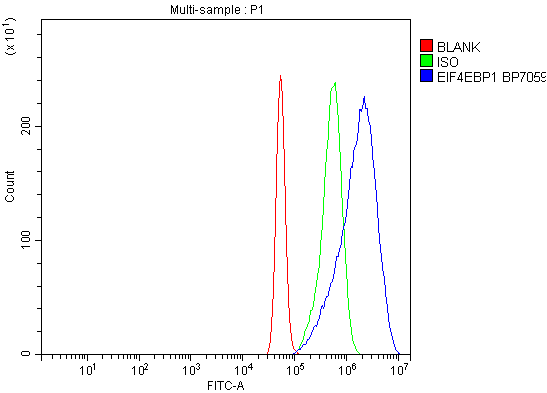| Western blot (WB): | 1:500-2000 |
| Immunohistochemistry (IHC): | 1:50-400 |
| Flow Cytometry (Fixed): | 1:50-200 |

Western blot analysis of 4EBP1/EIF4EBP1 using anti-4EBP1/EIF4EBP1 antibody (A00968-1). The sample well of each lane was loaded with 30 ug of sample under reducing conditions.
Lane 1: HEL whole cell lysates,
Lane 2: PC-3 whole cell lysates,
Lane 3: HEK293 whole cell lysates,
Lane 4: rat stomach tissue lysates,
Lane 5: rat pancreas tissue lysates,
Lane 6: mouse pancreas tissue lysates.
After electrophoresis, proteins were transferred to a membrane. Then the membrane was incubated with rabbit anti-4EBP1/EIF4EBP1 antigen affinity purified polyclonal antibody (A00968-1) at a dilution of 1:1000 and probed with a goat anti-rabbit IgG-HRP secondary antibody (Catalog # BA1054). The signal is developed using ECL Plus Western Blotting Substrate (Catalog # AR1197). A specific band was detected for 4EBP1/EIF4EBP1 at approximately 17 kDa. The expected band size for 4EBP1/EIF4EBP1 is at 13 kDa.

IHC analysis of 4EBP1/EIF4EBP1 using anti-4EBP1/EIF4EBP1 antibody (A00968-1).
4EBP1/EIF4EBP1 was detected in a paraffin-embedded section of human lung cancer tissue. Biotinylated goat anti-rabbit IgG was used as secondary antibody. The tissue section was incubated with rabbit anti-4EBP1/EIF4EBP1 Antibody (A00968-1) at a dilution of 1:200 and developed using Strepavidin-Biotin-Complex (SABC) (Catalog # SA1022) with DAB (Catalog # AR1027) as the chromogen.

Flow Cytometry analysis of A431 cells using anti-4EBP1/EIF4EBP1 antibody (A00968-1).
Overlay histogram showing A431 cells stained with A00968-1 (Blue line). To facilitate intracellular staining, cells were fixed with 4% paraformaldehyde and permeabilized with permeabilization buffer. The cells were blocked with 10% normal goat serum. And then incubated with rabbit anti-4EBP1/EIF4EBP1 Antibody (A00968-1) at 1:100 dilution for 30 min at 20°C. Fluoro488 conjugated goat anti-rabbit IgG (BA1127) was used as secondary antibody at 1:100 dilution for 30 minutes at 20°C. Isotype control antibody (Green line) was rabbit IgG at 1:100 dilution used under the same conditions. Unlabelled sample without incubation with primary antibody and secondary antibody (Red line) was used as a blank control.

Western blot analysis of 4EBP1/EIF4EBP1 using anti-4EBP1/EIF4EBP1 antibody (A00968-1). The sample well of each lane was loaded with 30 ug of sample under reducing conditions.
Lane 1: HEL whole cell lysates,
Lane 2: PC-3 whole cell lysates,
Lane 3: HEK293 whole cell lysates,
Lane 4: rat stomach tissue lysates,
Lane 5: rat pancreas tissue lysates,
Lane 6: mouse pancreas tissue lysates.
After electrophoresis, proteins were transferred to a membrane. Then the membrane was incubated with rabbit anti-4EBP1/EIF4EBP1 antigen affinity purified polyclonal antibody (A00968-1) at a dilution of 1:1000 and probed with a goat anti-rabbit IgG-HRP secondary antibody (Catalog # BA1054). The signal is developed using ECL Plus Western Blotting Substrate (Catalog # AR1197). A specific band was detected for 4EBP1/EIF4EBP1 at approximately 17 kDa. The expected band size for 4EBP1/EIF4EBP1 is at 13 kDa.

IHC analysis of 4EBP1/EIF4EBP1 using anti-4EBP1/EIF4EBP1 antibody (A00968-1).
4EBP1/EIF4EBP1 was detected in a paraffin-embedded section of human lung cancer tissue. Biotinylated goat anti-rabbit IgG was used as secondary antibody. The tissue section was incubated with rabbit anti-4EBP1/EIF4EBP1 Antibody (A00968-1) at a dilution of 1:200 and developed using Strepavidin-Biotin-Complex (SABC) (Catalog # SA1022) with DAB (Catalog # AR1027) as the chromogen.

Flow Cytometry analysis of A431 cells using anti-4EBP1/EIF4EBP1 antibody (A00968-1).
Overlay histogram showing A431 cells stained with A00968-1 (Blue line). To facilitate intracellular staining, cells were fixed with 4% paraformaldehyde and permeabilized with permeabilization buffer. The cells were blocked with 10% normal goat serum. And then incubated with rabbit anti-4EBP1/EIF4EBP1 Antibody (A00968-1) at 1:100 dilution for 30 min at 20°C. Fluoro488 conjugated goat anti-rabbit IgG (BA1127) was used as secondary antibody at 1:100 dilution for 30 minutes at 20°C. Isotype control antibody (Green line) was rabbit IgG at 1:100 dilution used under the same conditions. Unlabelled sample without incubation with primary antibody and secondary antibody (Red line) was used as a blank control.


